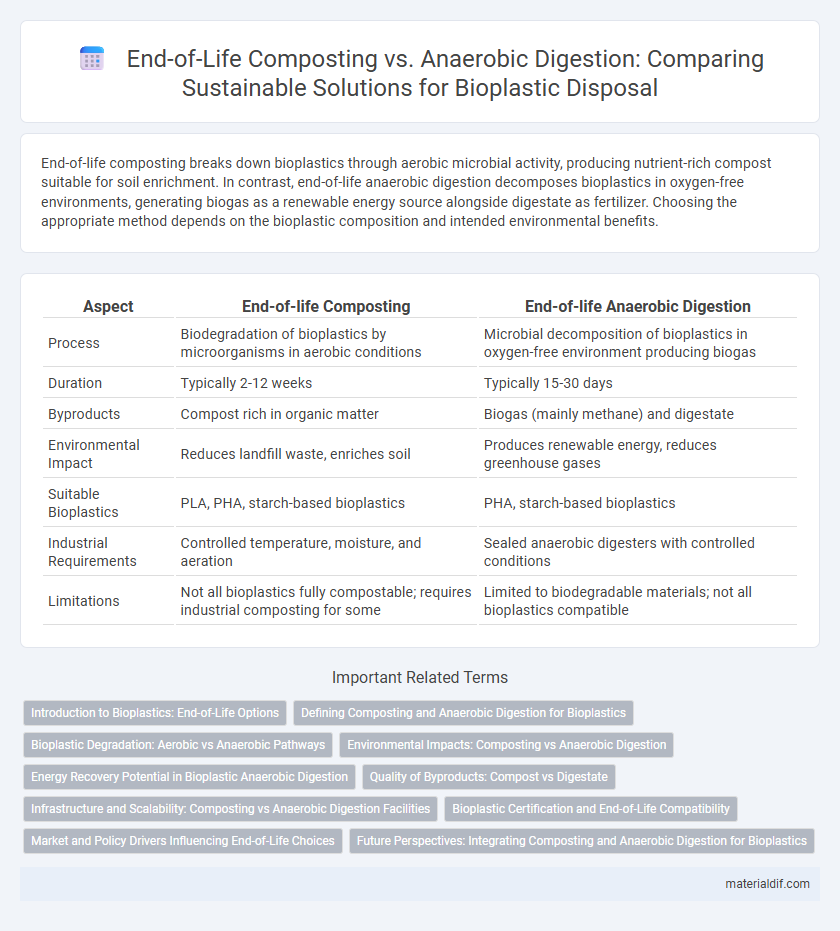End-of-life composting breaks down bioplastics through aerobic microbial activity, producing nutrient-rich compost suitable for soil enrichment. In contrast, end-of-life anaerobic digestion decomposes bioplastics in oxygen-free environments, generating biogas as a renewable energy source alongside digestate as fertilizer. Choosing the appropriate method depends on the bioplastic composition and intended environmental benefits.
Table of Comparison
| Aspect | End-of-life Composting | End-of-life Anaerobic Digestion |
|---|---|---|
| Process | Biodegradation of bioplastics by microorganisms in aerobic conditions | Microbial decomposition of bioplastics in oxygen-free environment producing biogas |
| Duration | Typically 2-12 weeks | Typically 15-30 days |
| Byproducts | Compost rich in organic matter | Biogas (mainly methane) and digestate |
| Environmental Impact | Reduces landfill waste, enriches soil | Produces renewable energy, reduces greenhouse gases |
| Suitable Bioplastics | PLA, PHA, starch-based bioplastics | PHA, starch-based bioplastics |
| Industrial Requirements | Controlled temperature, moisture, and aeration | Sealed anaerobic digesters with controlled conditions |
| Limitations | Not all bioplastics fully compostable; requires industrial composting for some | Limited to biodegradable materials; not all bioplastics compatible |
Introduction to Bioplastics: End-of-Life Options
Bioplastics offer sustainable end-of-life options including composting and anaerobic digestion, each supporting eco-friendly waste management. End-of-life composting breaks down bioplastics in oxygen-rich environments, producing nutrient-rich compost ideal for soil enrichment. Anaerobic digestion decomposes bioplastics in oxygen-free settings, generating biogas energy and digestate that can further enhance agricultural applications.
Defining Composting and Anaerobic Digestion for Bioplastics
Composting for bioplastics involves aerobic decomposition, where microorganisms break down organic material into nutrient-rich compost within a controlled environment, typically completed in weeks to months. Anaerobic digestion refers to the microbial process occurring in oxygen-free conditions, converting bioplastic waste into biogas (methane and carbon dioxide) and digestate over days to weeks. Both end-of-life options support bioplastic waste management but differ in environmental impact, energy recovery potential, and facility requirements.
Bioplastic Degradation: Aerobic vs Anaerobic Pathways
Bioplastic degradation occurs through distinct aerobic and anaerobic pathways, with end-of-life composting leveraging aerobic microorganisms to break down bioplastics into carbon dioxide, water, and biomass. In contrast, anaerobic digestion processes bioplastics in oxygen-free environments, producing methane, carbon dioxide, and digestate as byproducts. The efficiency and duration of bioplastic degradation vary significantly between these pathways due to differing microbial communities and environmental conditions.
Environmental Impacts: Composting vs Anaerobic Digestion
End-of-life composting of bioplastics results in faster biodegradation and nutrient-rich organic matter that improves soil health, significantly reducing landfill waste and greenhouse gas emissions. Anaerobic digestion processes bioplastics by producing biogas, a renewable energy source, while also generating digestate that can be used as fertilizer, contributing to circular economy goals. Composting typically emits lower methane levels than anaerobic digestion, but the latter's energy recovery potential offsets carbon emissions, making both methods environmentally beneficial with trade-offs depending on application and infrastructure.
Energy Recovery Potential in Bioplastic Anaerobic Digestion
End-of-life anaerobic digestion of bioplastics offers significant energy recovery potential by converting organic carbon into biogas, primarily methane, which can be used for electricity and heat production. Compared to composting, anaerobic digestion captures and utilizes energy from bioplastic degradation more efficiently while reducing greenhouse gas emissions through controlled microbial processes. This method also produces nutrient-rich digestate, enhancing its value for agricultural applications, making it a sustainable approach for bioplastic waste management.
Quality of Byproducts: Compost vs Digestate
End-of-life composting produces nutrient-rich compost that enhances soil structure, fertility, and moisture retention, making it ideal for agricultural use. In contrast, end-of-life anaerobic digestion generates digestate containing both solid and liquid fractions, which provide valuable nutrients but may require further treatment to balance pH and remove pathogens. Compost typically offers more stable organic matter, while digestate's higher nitrogen content supports rapid nutrient cycling yet demands careful management for optimal application.
Infrastructure and Scalability: Composting vs Anaerobic Digestion Facilities
Composting infrastructure is more widely available and can process a broader range of bioplastics, supporting scalability in urban and rural settings. Anaerobic digestion facilities require stricter feedstock controls and significant investment, limiting their current scalability for bioplastic waste. Expanding composting networks accelerates bioplastic biodegradation compared to the slower expansion of anaerobic digestion plants.
Bioplastic Certification and End-of-Life Compatibility
End-of-life composting certification for bioplastics, such as the ASTM D6400 and EN 13432 standards, ensures that the material biodegrades efficiently in industrial composting facilities within a defined timeframe, supporting environmental sustainability. Anaerobic digestion certification, guided by standards like ASTM D6868, validates the bioplastic's compatibility with methane-rich environments, enabling biogas production without toxic residue accumulation. Selecting the appropriate end-of-life pathway hinges on bioplastic formulation and certification, guaranteeing effective biodegradation or digestion and facilitating circular economy goals.
Market and Policy Drivers Influencing End-of-Life Choices
Market demand for sustainable waste management solutions drives the adoption of end-of-life composting for bioplastics due to its compatibility with existing organic waste streams and regulatory incentives in regions promoting circular economy practices. Policies such as extended producer responsibility (EPR) schemes and government subsidies favor composting infrastructure, encouraging manufacturers to design bioplastics that meet compostability standards. In contrast, anaerobic digestion gains traction where energy recovery from bioplastics aligns with renewable energy targets and where landfill diversion policies incentivize biogas production from organic waste, shaping end-of-life treatment preferences.
Future Perspectives: Integrating Composting and Anaerobic Digestion for Bioplastics
Integrating end-of-life composting and anaerobic digestion offers a promising future for bioplastics by enhancing waste management efficiency and resource recovery. Combining these processes can optimize biodegradation rates and nutrient recycling, reducing environmental impact and supporting circular economy goals. Advances in biotechnology and process engineering will drive synergistic systems that improve the overall sustainability of bioplastic disposal.
End-of-life Composting vs End-of-life Anaerobic Digestion Infographic

 materialdif.com
materialdif.com